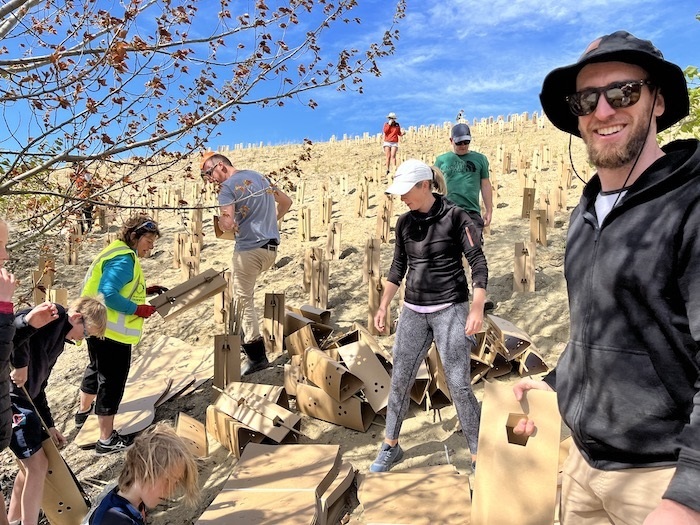Cromwell’s largest planting event
Cathy Romeyn
10 October 2022, 4:45 PM
 A Chinese proverb says “the best time to plant a tree was twenty years ago. The second best time is now”
A Chinese proverb says “the best time to plant a tree was twenty years ago. The second best time is now”The largest community planting event ever seen in Cromwell was held at the weekend (October 8- 9), when over 10,000 native trees and shrubs were planted on the bank above McNulty Inlet.
The effort was part of the Lake Dunstan Charitable Trust (LDCT) Bridge to Bridge project, in partnership with Trees that Count, Te Tapu o Tāne – Growing Trees and Communities and Land Information New Zealand (LINZ).
By 2024, an estimated 56,000 native plants will stretch from Lowburn Bridge to Deadmans Bridge.
“By doing our bit to restore native vegetation we can do our bit in the fight against climate change, habitat loss and species decline,” Te Tapu o Tāne community connector Megan Phillips said.

Megan talking with our future guardians of the lake
Propagating the thousands of seedlings required for the project started about two years ago by iwi-led charitable venture Te Tapu o Tāne in their nursery based near Invercargill.
“We collected seeds, identified and then propagated them over about the last two years,” Te Tapu o Tāne operations manager Dean Stuart said.

Dean with some of the 10,000 plants
The seedlings were then “hardened off” in readiness for the Central Otago conditions.
“We worked with e3 Scientific to establish the pH of the soil here, the top soil required, mulch to use, watering requirements and so on,” Dean said.
The hard yards of preparing the 10,000 holes coincided with the “polar blast” last week, but the volunteers from Trees that Count soldiered on.
Trees that Count, a conservation charity, received government funding in honour of the late Queen Elizabeth II as part of her Platinum Jubilee celebrations. The charity works with the Department of Conservation and identified Lake Dunstan Charitable Trust’s work as one of 15 outstanding native restoration projects.

Rough Milne Mitchell Wanaka lead landscape artist Gerald O’Connell master-minded the overall planting plan
The people-power required to achieve the massive feat of getting plants into holes came from the Cromwell community, which came out in force.
Not only were volunteers rewarded with the satisfaction of knowing they were increasing the local biodiversity (and improving recreational access and use of the lake’s shoreline) – but also with food: freshly baked and plentiful.
Young people involved with the Cromwell Youth Trust stepped up, put their aprons on and whipped up a treat.
Senior youth worker Fran Dustin said the teenagers took on the task enthusiastically and did the “mahi with aroha”, “they really wanted to be involved and contribute,” she said.

Fran (at back) with baker-of-biscuits, Philip Meikle (14), youth work supervisor Zee Whittington, and two-year-old Aleksey Bingham





